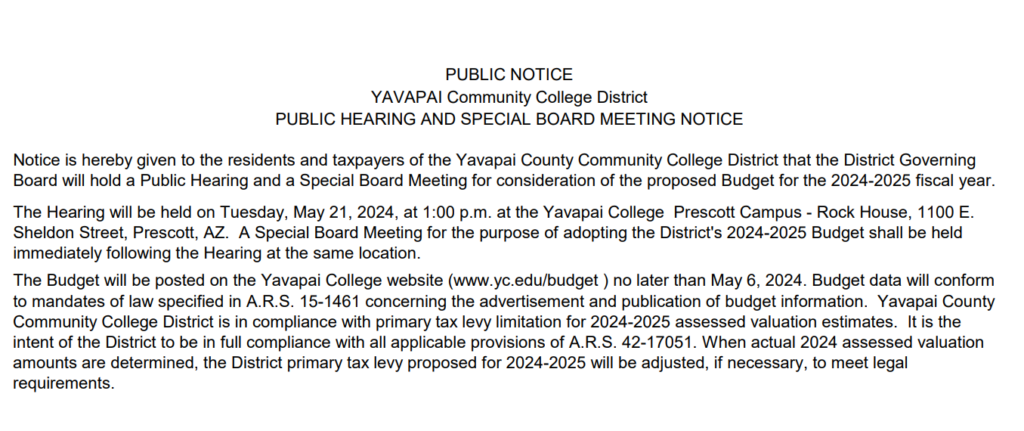College expected to request approval at May meeting of $16 million revenue bond, refinance of existing revenue bonds, and around 4% County property tax increase. Board agreed at April meeting to reduce fund reserve accounts to free up about $2 million of additional revenue annually
 Yavapai Community College is seeking significant funding from new sources to successfully complete its extensive capital expenditure plan on the west side of Yavapai County. While estimates vary, the College may need as much as $60 million to complete three major capital projects.
Yavapai Community College is seeking significant funding from new sources to successfully complete its extensive capital expenditure plan on the west side of Yavapai County. While estimates vary, the College may need as much as $60 million to complete three major capital projects.
To secure funding for the projects, the College plans to propose several financial strategies at the May public Taxation hearing. These include:
- Issuing a $16 million revenue bond.
- Refinancing existing bonds to release additional funds.
- Proposing a 4% increase in the county property tax rate.
At a meeting on April 21, 2023, the District Governing Board revised its cash reserve policy, which will make about $2 million available annually.
The funds raised will support three key initiatives:
- The Digital Learning Commons at the Prescott Campus, which involves a complete overhaul of the current library.
- The acquisition and renovation of a 41-acre camp near Prescott, which will initially use about $5 million from reserves to purchase but will require at least $6 million more for refurbishments.
- The construction of the Health Science Building at the Prescott Valley Center, with cost estimates ranging from $20 million to $40 million, depending on the final design.
The decisions on the proposed tax increase and bond issuance will be made at the public hearing scheduled for May 21, 2024, at the Rock House.

To read the posted proposed budget for 2025, please click here.
 Yavapai Community College Vice President of Finance and Administrative Services, Clint Ewell, reported to the District Governing Board at its March meeting that the College’s bond indebtedness was quickly moving toward total payoff. He said that bonds issued in 2000 were now completely paid off as of this year and bonds issued in 2012 were close to being completely paid off.
Yavapai Community College Vice President of Finance and Administrative Services, Clint Ewell, reported to the District Governing Board at its March meeting that the College’s bond indebtedness was quickly moving toward total payoff. He said that bonds issued in 2000 were now completely paid off as of this year and bonds issued in 2012 were close to being completely paid off. The General Obligation bonds are approved by voters and used for capital projects. The last time voters in Yavapai County approved General Obligation bonds was in the year 2000 when they approved issuance of $69.5 million dollars in bonds for the Community College.
The General Obligation bonds are approved by voters and used for capital projects. The last time voters in Yavapai County approved General Obligation bonds was in the year 2000 when they approved issuance of $69.5 million dollars in bonds for the Community College.